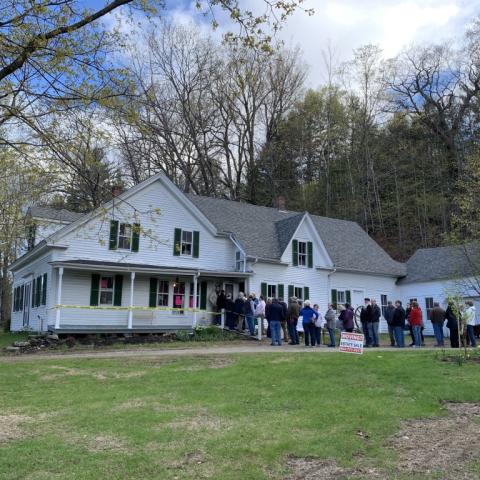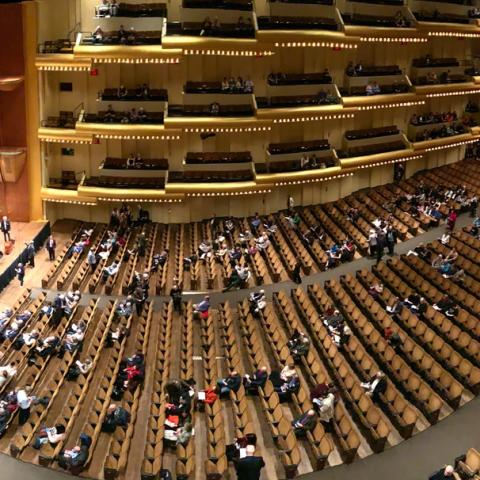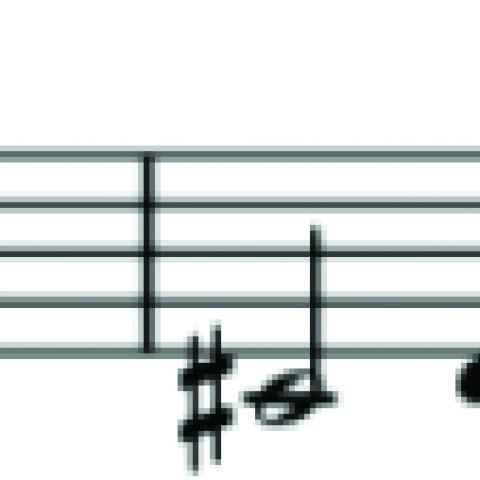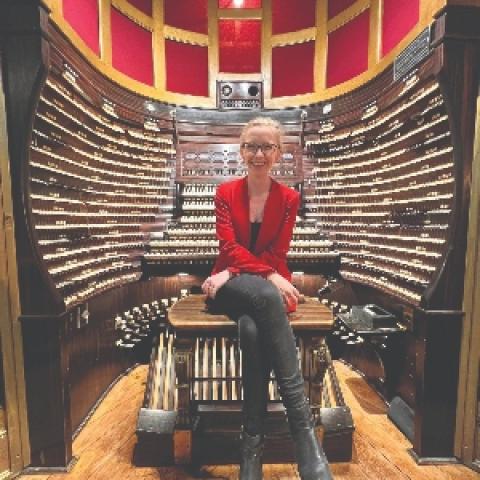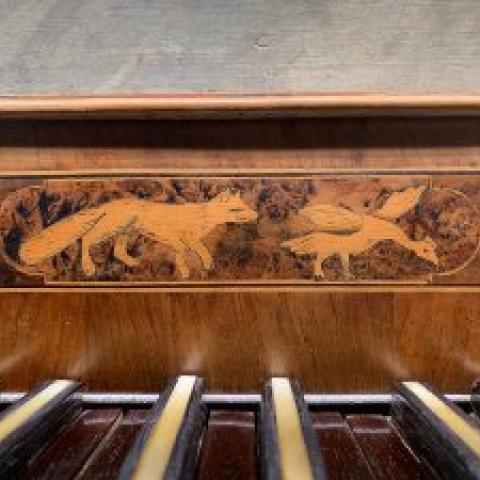
Why art?
Raphael’s Sistine Madonna is a magnificent and monumental painting. Almost nine feet tall and more than six feet wide, it is a compelling work in which I see a shy and slightly frightened Mary holding a burly infant who sports a Gotti-esque pout. (Whadaya gonna doo?) Saint Sixtus, the patron saint of the church for whom the painting was commissioned, is shown in the thrall of the mother and child, and Saint Barbara, whose presence was also specified by the commission, looks down at two putti resting their chins, arms, and elbows on the bottom frame of the painting.
Because of its huge scale and rich colors (it’s my guess that in real life, Mary never had such opulent garments), it is a real eye catcher, but those two little imps are the stars of the show. A legend says that they were the children of Raphael’s model, and he painted them just as they looked six hours into the tenth day of watching their mother stand still for the master. Their expressions convey both disinterest and cunning, and they are clearly not impressed by the exalted infant. As grandfather of two boys about the ages of the putti, I have seen those expressions before, and know that they signal time for a diversion. “Hey, boys, let’s go outside.”
Raphael’s putti have been plucked from the painting and reproduced and marketed as if they were nacho chips or soda pop, appearing on post cards, coffee mugs, refrigerator magnets, and tote bags. They are adorable, but something of the original poignancy is lost.
When the pope commissioned the painting, did Raphael take it on as a job, happy to have the income and simply accepting that he was better at painting than others, so it was natural that it would be his job? Or did he take it on as a spiritual challenge, setting out to do something so good that mere mortals would never be able to fully understand?
You can order a 16′′ x 24′′ framed print of Sistine Madonna from Amazon for $29.99, and a 9.5′′ x 7.9′′ mouse pad picturing the putti for $9.99.
Musicians know that the music of Bach or Mozart is the work of genius. When you study the music mathematically and theoretically, you get a sense of what the composer had in mind. But for all its majesty and intricacy, I heard “Brandenburg Five” playing at Starbucks the other day when I ordered coffee. If the barista had been a struggling young musician, perhaps she would have worked the steam nozzle in time with the music. A little puff of steam on “one and three” would have been cute. But no. Bach’s ingenious creation was coexisting with her off-beat steam punk, competing with the grinder reducing my beans for espresso and the gabbling of the women wearing headsets working the drive-thru window.
Michelangelo’s David in a snow globe; Rodin’s Thinker as a paperweight; Rondo ala Turca in an elevator; history’s artistic milestones reduced to the commonplace. Wendy and I are lucky to live in New York City, where great museums are sprinkled across the map, and we can experience many of the greatest artworks at the other end of a short subway ride. Van Gogh’s Starry Night looks fine on a t-shirt, but when you see it in person in New York’s Museum of Modern Art, it takes your breath away. Monet produced around 250 “Water Lilies” paintings, all showing scenes of the beautiful gardens at his home in Giverny. Just like Starry Night, they look nice on t-shirts, but if you have only seen them in that format, you might not realize that they get as big as 13 by 41 feet. That is a huge amount of paint for someone who was suffering from cataracts.
As Monet produced hundreds of gorgeous images in spite of failing eyesight, so Beethoven gave us some of the most sublime, defiant, innovative, and powerful masterworks of music as he was losing his hearing. We know enough about him to have a sense that he could be cranky. If your life is creating spectacular music, I will forgive you a fit or two if you are losing your hearing. A legend has Beethoven playing the piano for a group of socialites in a lavish drawing room, angered by their inattention and chatter, slamming the fall board, standing up to announce, “For such pigs I will not play,” and storming out of the room.
§
Dictionary definitions of art use phrases like, “. . . works to be appreciated primarily for their beauty or emotional power.” Art is pictures, sculptures, music, literature, and drama. Art can be fiction or non-fiction. A bowl of pears and grapes sitting on a table next to a candlestick may be a non-fiction subject, but the fact that every glistening drop of moisture, every vein in a leaf, and iridescent surface of the fruit is represented in paint applied by human hands is the art part. That still life is art because of its beauty more than its emotional power, while Starry Night is all about emotional power.
A painting that depicts a historical event, a battle, or an armistice for example, would be non-fiction. But what about a painting of a biblical scene? Asking whether The Last Supper is fiction feels like a great way to start an argument. I am guessing that most texts that have been set to music are fiction. Most operas and most art songs are fables, allegories, stories, or poetry. I am afraid to categorize sacred music that way. Like The Last Supper, it feels a little dangerous to ask if the Latin Mass is fiction.
But what about a trio sonata, a symphony, or a piano concerto? Can they be defined as fiction or non-fiction? There is something abstract about the concept of music, even tonal music that is controlled and defined by complex sets of rules. It is sound that is organized vertically in chords, all of which are ultimately derived from the overtones that are the structure of any musical note, and it is sound that is organized in time. How chords progress from one to another, how counterpoint allows multiple independent lines of music to intertwine, converting melody into harmony is somehow both logical and mystical. Could that oxymoron be the definition of why music is art?
Michelangelo rendered human flesh, including sensitive facial expressions, in marble. Rodin left us a fleet of sensual and sensuous images in bronze. Manipulating such dense materials with such sensitivity is the essence of art, images that transcend the inanimate quality of their materials.
Music as art is magical because it is fleeting. It happens at the present, and the present is infinite. Each nanosecond is another right now! The motion of a piece of music is like the bow wave of a boat, moving relentlessly through an infinite series of “right nows.” As we play or as we listen, we store up the memories of those infinite moments and assemble the progression of sound into our perception of the music. There is a wonderful photograph of Pablo Picasso tracing the outline of a bull with a flashlight, captured on a long exposure. That seems the closest link between pictorial art and music.
We have invented a recognizable written language to record music, so the creation of the composer can be saved for reproduction. Music is an art, but unless there is a performer who can realize it, is it anything more than notations? We consider a performer to be an artist, but unless the performer is improvising, inventing music on the spot, the art of music is the interpretation of someone else’s inspiration.
We talk about artistic temperament. The phrase is sometimes used to excuse someone’s bad behavior, but at its best, artistic temperament is a frame of mind for expressing beauty or powerful emotions. The splendid Russian baritone Dmitri Hvorostovsky, who died at the age of fifty-five in November 2017, could express the full depth of human emotion with a twitch of his lips. Before he sang a single note, you knew you were in for something special. I strongly recommend treating yourself to twenty minutes on YouTube, entering his name in the search bar, and watching his every move. Musicianship and artistry do not get any better.
§
Last week, sitting in the hundred-fifty-year-old second-floor theater (complete with tin ceiling) in downtown Damariscotta, Maine, Wendy and I saw John Logan’s play, Red, as filmed in a live performance at London’s Wyndam Theater in the summer of 2018. It is a ninety-minute production with five scenes, performed without intermission, portraying a two-year period in the life of artist Mark Rothko. Rothko and his assistant, Ken, are the only two characters, and those two years exactly span Ken’s employment in Rothko’s studio. Ken’s entry to the stage a few moments into the play is the moment he is hired.
The play is set in 1958–1959 in Rothko’s studio at 222 Bowery, an abandoned gymnasium. The title is derived from the commission Rothko is working on, a series of monumental murals for the new Four Seasons Restaurant in New York City’s Seagram Building, designed by Ludwig Mies van der Rohe and Phillip Johnson. Rothko makes no secret of the fact that he views this commission as the opportunity of a lifetime. He is being paid $30,000 for it, which he feels is a huge amount of money. Ken is expected to be very impressed by that. Rothko is crushed to learn that Jackson Pollack is Ken’s favorite artist, and throughout the play, the action circles around Rothko’s enormous ego.
Rothko denigrates Pollack, saying that success is the worst thing that ever happened to him, and ridiculing him for owning an Oldsmobile convertible. Racing around Long Island in that car was the antithesis of art. Pollack died in a drunken crash in that car, and Rothko called it a “lazy suicide.” He continues, “believe me, when I commit suicide there won’t be any doubt about it.” (In fact, Rothko did commit suicide with a combination of barbiturates and razor blades. There was no doubt about it.) He goes on to criticize Andy Warhol, Roy Lichtentstein, and Robert Rauschenberg for selling out to commercialism.
The irony of all this, given the $30,000 commission, is not lost on Ken. Rothko is obsessed with the progress of the work and of his greatness, until late in the play, Ken explodes in pent up fury and frustration. “Not every painting has to be so . . . important all the time! Not every painting has to rip your guts out and expose your soul! Not everyone wants art that actually hurts! Sometimes you just want a . . . still life or landscape or soup can or comic book.” The fight continues until Ken bursts out with, “Just admit your hypocrisy: The High Priest of Modern Art is painting a wall in the Temple of Consumption. You rail against commercialism in art, but pal, you’re taking the money.”
The last scene opens with Rothko arriving at the studio the following morning. He tells Ken that he went there. Where? The Four Seasons. He is horrified by the experience, the naked consumerism, the spectacle of the city’s wealthiest people trying to impress each other by spending too much on dinner. He picks up the telephone, dials a number, and asks for Mr. Philip Johnson. “Philip, this is Rothko. Listen, I went to the restaurant last night and lemme tell you, anyone who eats that kind of food for that kind of money in that kind of joint will never look at a painting of mine.” Ken is pleased to have made his point so dramatically, but two lines later, Rothko fires him, and the play ends.
Rothko is the big loser in this story, and the eerie foreshadowing of his suicide is a poignant part of the play. Alfred Molina created the role of Rothko and repeated in the revival production we saw. Eddy Redmayne was the original Ken—in this production we saw Alfred Enoch playing Ken. Red won a Tony Award for Best Play in 2010, and Eddy Redmayne won a Tony that year for Best Performance by a Featured Actor in a Play.
Red was screened in theaters in the United States and the UK on November 7. I do not know if there are plans for it to be screened again. Perhaps it will be available through Netflix or Amazon? Keep your eyes open for it. It is a profound lesson for any artist.
§
Who among history’s great artists had a Rothko-esque ego? Rembrandt? Picasso? Michelangelo? Turner? And who among composers? Mendelssohn? Vivaldi? Gounod? Bruhns? It is easier to name performing musicians. Kathleen Battle’s early career was crammed with magnificent performances and recordings, but twenty years later, she had developed a terrible reputation for her elevated ego and poor treatment of the people around her. After a performance with the Boston Symphony Orchestra in 1992, The Boston Globe reported that she left behind a “froth of ill will.” And in February 1994, Joseph Volpe, general manager of the Metropolitan Opera Company, fired Battle from her leading role in La Fille du regiment, citing “unprofessional actions during rehearsal . . . conduct profoundly detrimental to the artistic collaboration between all the cast members.” Time magazine reported that the cast applauded when informed of her dismissal. She never returned to the opera stage.
§
I know many organists who have been badly treated by clergy. For example, it is pretty common to hear tales of woe about priests who felt overshadowed summarily dismissing successful musicians. But I am troubled by haughty attitudes I often encounter among musicians. A stopknob engraved “Rector Ejector” may be a cute gag, but the thing can get out of hand. I see all sorts of complaints from church musicians on social media, dismissing people who think the organ is too loud, making snide remarks about clergy, and chiding the “ignorant” congregants as if they are not worthy of your music.
I was a regular church musician for about thirty years and gave up the bench twenty years ago when I joined the Organ Clearing House because the travel schedule was not compatible. That means I have a lot more chances than most organists to sit in the pews as a worshipper, and you know what? The organ is often too loud. As much as I love the sounds of a powerful organ, I find it tiring. Every verse of every hymn does not need to include Mixtures. It is refreshing for the congregant if the organist mixes it up a little, changing colors between verses, and saving the big guns for the right moment. If you are playing a gentle hymn, play it gently. When a hymn starts with a huge crash, it can be jarring for people who did not know it was coming. The organ is a musical instrument, a living, breathing thing that encourages people to sing if you do not frighten them.
Ken accused Mark Rothko of acting as though no one was good enough to view his paintings. According to Rothko, museums are mausoleums and art dealers are pimps. Rothko railed against the client who asked to commission a painting that would “go” with a certain couch, and he used the term “overmantle” to denigrate the client who wanted a painting simply to fill a space.
Music is a public art that requires both composer and performer to make it happen. And, of course, it requires listeners who are engaged and who participate in the act of music, especially when they are invited to sing and be part of the performance. A bumper sticker popular among people who race sailboats says, “Have you flogged your crew today?” One for organists could be, “Have you flogged your congregation today?”
Ultimately, Rothko realized that he could not control a commercial space with his paintings. Unfortunately, he was so tied up in his high opinion of himself that suicide was inevitable. He mentioned it himself in a Freudian slip.
Organists: what you do is special. It is an unusual art and a special gift. Invite the people of your church in. Share the majesty and the mystery of your instrument with them. Teach them to appreciate the art as you envelope them with beauty. Never forget that they paid for the instrument that it is your privilege to play. Show them that it was worth it.

